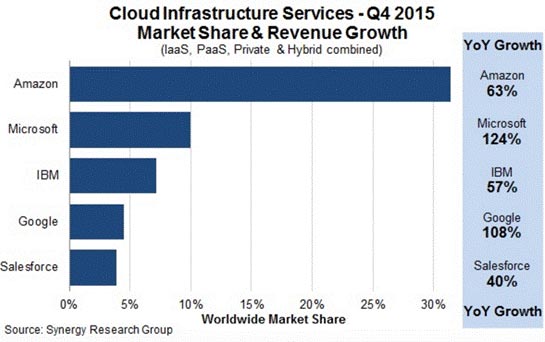Amazon Cloud Essentials: 5 Facts You Need to Know
Amazon Web Services (AWS) is a subsidiary of Amazon that offers a large suite of infrastructure and application services that enable you to run nearly everything in the cloud – from enterprise applications to large data projects and mobile apps. AWS is the industry’s market leader, with customers spread over almost every country throughout the world, and a huge share of the Infrastructure as a Service (IaaS) market. In fact, in 2015, Gartner estimated that AWS customers are deploying 10 times more infrastructure on AWS than the adoption of the next 14 providers combined.
AWS is the industry’s market leader, with customers spread over almost every country throughout the world, and a huge share of the Infrastructure as a Service (IaaS) market. In fact, in 2015, Gartner estimated that AWS customers are deploying 10 times more infrastructure on AWS than the adoption of the next 14 providers combined. In this article, we’ll present five things you should know about AWS, and tell you why this vast-reaching organization is so important in the world of cloud computing today.
1. The Global Reach of AWS
AWS has an active customer base of over 190 countries, and more than a million active customers – including nearly 2,000 government agencies, 5,000 education institutions and more than 17,500 non-profits. The AWS global infrastructure is comprised of 33 availability zones across 12 geographic regions worldwide, with five additional regions expected to be added in 2016. Today, more than one-third of all Internet users visit a site or application powered by AWS. AWS data centers are located in the U.S., Europe, Brazil, Singapore, Japan, and Australia. Amazon scales up capacity by adding new data centers – with the idea that customers are architecting their applications for local data protection.
2. A Lion’s Share of the Market
AWS has a huge market share of the cloud computing sector. As illustrated in the image below, AWS is as big as its next four competitors combined. 
3. Dynamic Financials and Explosive Growth
With Amazon’s latest financials, it’s not hard to see how fast the AWS unit is growing and contributing to the company’s bottom line. In Q1 2016, AWS was the most profitable segment of the entire Amazon business, with operating income for AWS coming in at an impressive $604 million — more than half of the operating income for all of Amazon in the quarter! AWS generated $2.6 billion in revenue during the first quarter, representing an impressive 64 percent year-over-year growth.
4. API Calls: Facts and Figures
Amazon API Gateway is composed of two services: the API Gateway control service and the API Gateway execution service. An app can interact with the API using standard HTTP protocols, or using a platform- or language-specific SDK generated by the API creator. Many AWS API service limits cannot be changed, and increasing any of the limits requires requesting and obtaining approval from AWS. The following are the current API Gateway limits for AWS.
- 60 APIs maximum per AWS account.
- 10,000 API keys per AWS account by default.
- 60 client certificates maximum per AWS account.
- 300 resources maximum per API.
- 10 stages maximum per API.
- 30-second timeout for both AWS Lambda and HTTP back-end integrations. This limit cannot currently be changed.
- 10MB payload size, which cannot currently be changed.
Detailed information on AWS API calls can be found on the AWS API Gateway Limits site.
5. History, Growth and Future Trends
In 2006, Amazon began their web services with S3 storage and EC2. With the ability to ‘rent’ computer storage, this essentially became the beginning of cloud computing. Since then, AWS has mastered abstracting the underlying compute, storage, and networking features from developers, so that they can focus more easily on simply creating applications. Today you can utilize more than 70 Amazon services, including software, networking, analytics, mobile, database and others. New services are quickly provisioned, without the need for upfront capital expenses. This allows enterprises and others to access the building blocks they need to respond quickly to changing business requirements.
As AWS continues to grow and innovate, their do-it-yourself approach with pre-defined customer-friendly packages has greatly simplified the time spent on deploying servers and managing them remotely. With the global market for cloud computing anticipated to grow from $40 billion to over $240 billion in the next 10 years, AWS stands well-positioned to take advantage of the vast opportunities ahead of them for the next several years and beyond.